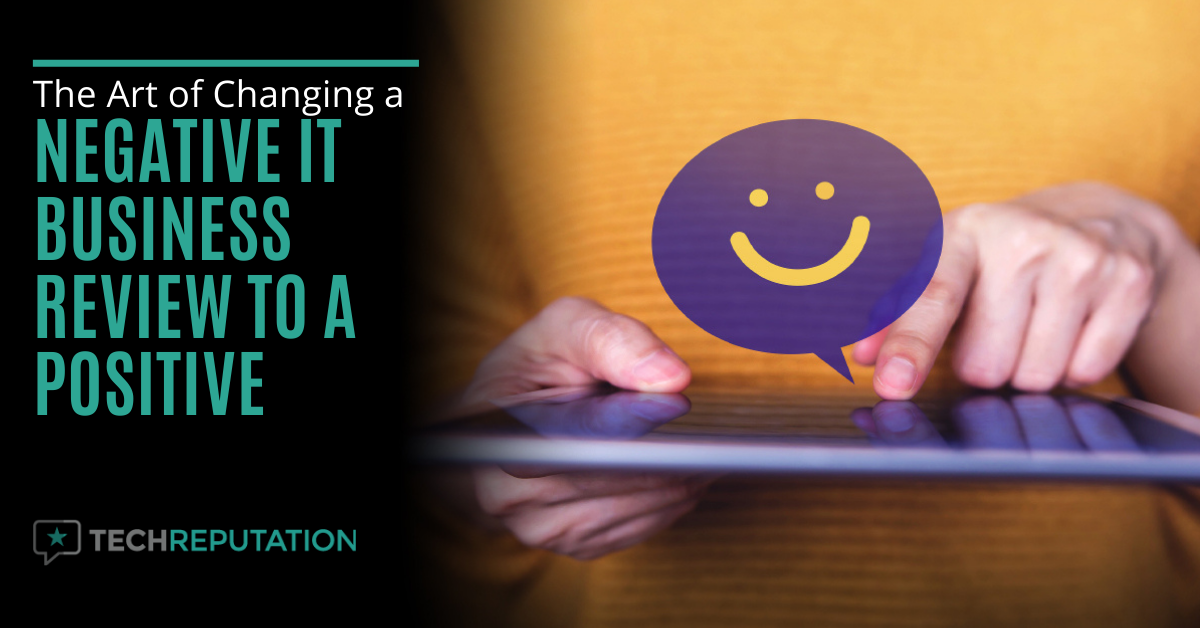The Art of Changing a Negative IT Business Review to a Positive

Promoting online reviews can bring your IT business tons of accolades and can also bring you plenty of sour grapes.
Some MSP business owners even shy away from asking for reviews at all because they’re afraid that one bad one will cost them business.
But those reviews are coming for you on sites like Google and Yelp, whether you promote them or not. So, it’s best to engage and learn the art of changing negative reviews into positives ones. (Yes! It can be done!)
Understanding the Psychology of Reviews
Reviews are a big part of the buying process for a majority of people and a main part of a health marketing engine. So, just ignoring them and hoping you don’t get a bad one, isn’t an option. IT business owners need those reviews to make sales, just as much as people that have had a good or bad experience feel they need to write one.
It’s vital to have a reviews strategy as a part of managing your IT business reputation.
91% of people read online reviews to help them make a buying decision and 84% of people trust reviews just as much as a recommendation from a friend.
Before we get into some of the tactics to take to finesse those bad reviews into a positive for your business, let’s discuss some of the psychology behind reviews. Understanding why someone is writing a review (good or bad), will help you better interact with negative reviews to transform them to your benefit.
Here’s some of the key motivators that cause people to write a negative review for a product or service.
To Have Their Voice Heard
In the internet world people can be heard much more easily than before we had Twitter, Google Reviews, and Facebook. Have a frustrating airline experience? Just tweet the airline using their @name, and you’re bound to get a response pretty quickly.
83% of consumers expect companies to respond to social media comments in 24 hours or less.
People that have a good or bad experience with a product or service want to be heard by the company. For bad experiences, they expect to have things made right.
What can you learn from this?
Responding promptly with a fix for the problem can make a big difference.
They’re Upset in the Heat of the Moment
While there aren’t any hard statistics on this, I’d bet that the most virulent reviews are written immediately after someone has had some type of bad experience with a company.
Negative reviews are often written in the heat of the moment when someone is upset and not thinking as their “best self.”
What can you learn from this?
A person that writes a really bad review might be easier to reason with than you think once they’ve cooled down.
They Want to Warn Others
Some reviewers feel they’re doing a public service by writing a negative review. Because they had a bad experience, they feel it’s their duty to tell others about it.
What can you learn from this?
It’s important to have an MSP reviews program so those reading reviews can judge for themselves if someone’s experience is an anomaly based upon all the positive reviews you have alongside it.
How to Turn Negative Reviews Around to Your Favor
When taking steps to turn negative reviews to a more positive outcome for your business, there are two objectives and potential outcomes:
- The reviewer actually edits their review from a negative to a positive one after you’ve fixed their problem.
- The reviewer doesn’t edit their review, BUT others reading the review feel good about your company anyhow because of how you handled, or tried to handle, the person’s issue.
Here are some tips for getting one or both of those outcomes from a negative review.
Respond to Negative Reviews Promptly
Review platforms show the date a review and replies were posted. Some even include the exact time. Imagine someone is reading through your reviews and sees one from someone that had a problem with a technician showing up hours late for an appointment.
They may see that review was posted on a Monday, February 1st and your company didn’t respond until 2 weeks later. Immediately, your response (and how good it might have been) becomes secondary to the fact that you took so long to respond. Giving credence to the reviewer’s complaint related to your business being unreliable.
If you respond promptly to reviews, you gain a few brownie points right away. The sheer fact you responded so quickly, gives you credibility in both the eyes of the person that wrote the review and those reading it.
This can make the reviewer more willing to listen and change their opinion (and possibly review) about you.
Stay Professional When Replying (Don’t Lose Your Cool!)
Let’s face it, it’s easy to have your temperature rise off the charts in a matter of milliseconds when you read a negative review about your MSP business. But responding defensively or sarcastically (i.e., “Well, if you had answered one of our 7 voicemails, maybe you would’ve known your computer was ready for pickup.”)is only going to hurt you.
You need to realize that even in the face of an unfair review, it’s important to keep your cool and stay professional and helpful with your reply. You’re not just writing it for the reviewer, you’re writing it for sales leads that you may get for years to come that are reading that reply before deciding on IT support.
7 out of 10 consumers changed their opinion about a company after they read their reply to a review.
Reply tips for negative reviews:
- Respond with a solution
- Invite the person to contact you
- Be polite (even if the other person isn’t)
- Don’t be defensive or get dragged into an online battle
- Write the response as if it were going up on your site’s front page
Acknowledge What They’ve Said & How They Feel
One of the classic foundations of miscommunication is when someone thinks someone means one thing, when they actually mean something completely different.
You can mitigate confusion as well as let the reviewer know that you’ve “heard” them by acknowledging what they’ve said as well as how it made them feel.
For example, if someone is upset because they misunderstood that your managed antivirus was billed monthly and not a one-time purchase, you may not be in the wrong at all, but can still acknowledge their feelings.
Such as, “I understand that you thought our monthly managed antivirus service was a one-time purchase software. We apologize for any confusion and know that must’ve made you feel as if we double billed you, when that wasn’t our intent at all.”
Apologize, But Also Politely Stick Up for Yourself
This next tip is somewhat tricky. First, if you’re in the wrong, apologize for that. Even if you weren’t in the wrong, you can still apologize for “any confusion” or “that you felt that way” without taking blame for something that wasn’t your fault.
You can politely stick up for yourself by using phrases like, “that wasn’t our intent” or “while this situation is out of the norm for our company, we strive to ensure everyone has a great experience.”
Watch the sarcasm! Its easy to pick up on by adept review readers. Be sincere and honest with your reply.
One other situation that can come up is a review written about you from someone you never heard of. This can be the case of someone mistakenly choosing your company on Google instead of the one they actually worked with, or it can be sabotage by a competitor.
In either case, here is a way you can politely stick up for yourself when you get a bad review that you suspect isn’t from a customer: “We are sorry to hear about your experience. We have combed our records for any record of this service call or your information and cannot find that we’ve had any customers that match. Might you be trying to reach a different IT provider? Please contact us at X and we’ll work to get this cleared up.”
Move Discussions Offline
You don’t want to have a back-and-forth discussion with a reviewer in a public forum. For one, they could end up accidentally revealing sensitive details, like how much their paid or their account number.
Second, when you write a review reply it’s to solve the issue and move the discussion offline, not to give the online world a dramatic exchange to read.

Once you’ve acknowledged the issue and either suggested a solution or let them know you’d like to hear more, offer your business contact details so they can reach out, or if you know who it is and have their details, reach out to them.
The goal is to continue the resolution offline and do your best to make the situation right if possible.
If the person replies something like, “No way I’m contacting you! Not worth my time!”, then at least you know you tried to make things right, and so will everyone else reading the exchange.
Fix the Issue If You Can
Ideally, you want to solve the issue the customer wrote the negative review about. So, if you can, make a concerted effort to make the customer happy or solve the problem.
This may seem obvious, but not all MSPs will try to resolve an issue from a past customer if they don’t think they’ll bring them more business. But for good word of mouth and just good karma, it’s something that brings positive things for your business in the future.
Also, you can’t ask someone to change their review from negative to positive if you haven’t fixed the problem.
Politely Ask People Change Their Review Once You’ve Fixed the Issue
I’ve often run across reviews that started off negative but had a high star rating. When I read further, I saw that the reviewer edited their rating and included a note in the review that the issue was resolved.
Some reviewers will edit their reviews and ratings if asked. Of course, you need to do this respectfully and not as an expectation after you’ve fixed something.
It never hurts to add to the end of an email after an issue was resolved that, “If you feel so inclined, it would really help us out if you edited your review on Google to reflect your updated experience with our company.”
This way you’re not presumptuously telling someone to give you a good review but are asking them politely to consider changing their review to reflect their more positive experience.
Master Your Negative Reviews!
With a little finesse, negative reviews aren’t so scary at all and can actually be turned around to a positive for your IT business.
What has been your most challenging review experience? Share your stories in the comments!
Leave a Reply